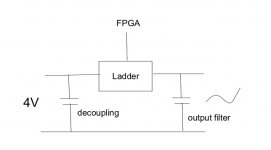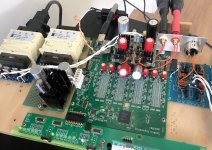in my experience even the cheapest foil caps are better in PSU than any lytic.
This is a very useful observation as it illustrates how different perceptions can be.
Always wanted to like an electrolytic cap free PS but couldn't. Even in my valve preamp with all the chokes and regulators the absence of a fat lytic, makes me feel something important is missing.
Yet CJ, among others, had several models with film caps instead of 'lytics and many seemed to like them.
A bit off topic...but if you heard a Kemet 944u - 600uF or better a Cornell 947D in your tube amp PSUs you are done with the lytics, I promise you. Compared to BG, they are a steal price wise. The 947D are a new generation of Polyprops, very unique sounding and impressive technical specs...that is why the guys from Aries Cerat use them in the Billionaires-Audio-Equipment...they got there something cooking.
But hey Jogi....you brought TNT finally onto the same page ? Cant believe this has happened...😉 Did he just admitted that ceramics could sound bad ?
But hey Jogi....you brought TNT finally onto the same page ? Cant believe this has happened...😉 Did he just admitted that ceramics could sound bad ?
Good tip, thanks, will try them.
Ha! They're more expensive than NOS Cerafines or 4-pin Mlytics 😱
Ha! They're more expensive than NOS Cerafines or 4-pin Mlytics 😱
Last edited:
I did not care for a ceramic as a filter on the output. There was a big improvement echanging that. But in the PSU they have an other role as I see it.
//
//
But in your circuit both capacitors are pretty much in the same position. The only difference being the effect of the Vref filtering is bit dependent. The output filtering, otoh, covers a frequency range way outside audibility. It appears very reasonable that if one matters, so would the other.
Absolutely true, it all depends on many factors. Taste, preferences, habits and so on. In my tube stuff I always used a lytic as first cap for price and small footprint, as the difference is not that big. But close to the circuit they tend to blur the picture, if I may use this image. But in some hifi chains this may be wanted, in others not.This is a very useful observation as it illustrates how different perceptions can be.
And no, it wasn't me bringing TNT to his insight about ceramics, he deserves the credit himself😛
I wonder how this dac would sound with an integrated shunt reg for the Vref rails on the pcb...
Integrating it will be problematic - not enough space on board for the extra parts, let alone the heat management. An extra sandwiching board otoh is very realistic.
The existing circuit has a very sound concept as all the regulators rely only on the reference voltage for their output, not even resistors and this is why voltage matching is perfect. A similar concept is possible with an opamp based shunt, but if you insist on a non-nfb regulator, then it is not so trivial.
The existing circuit has a very sound concept as all the regulators rely only on the reference voltage for their output, not even resistors and this is why voltage matching is perfect. A similar concept is possible with an opamp based shunt, but if you insist on a non-nfb regulator, then it is not so trivial.
Yes, that would be a redesign of the PCB with some problems to master. But Soeren did implement some suggestions from the crowd, as long as it was easy enough to do. The output filter cap is one example, is now a Wima I think.
I was just dreaming about it, no particular plans. One easy thing to do would be some through hole vias to attach a good regulator, as they were present for additional Vref caps in the 1021. And 2 or 4 jumpers to take the onboard regs out without the need to desolder them.
Just sayin...
I was just dreaming about it, no particular plans. One easy thing to do would be some through hole vias to attach a good regulator, as they were present for additional Vref caps in the 1021. And 2 or 4 jumpers to take the onboard regs out without the need to desolder them.
Just sayin...
Wouldnt it be a good, simple start to try something better than Lm431... leave the opa365 in, see what happens...
Soldering the ultrabibs currently...on sunday I will see what they will do vs. lt3042...
Soldering the ultrabibs currently...on sunday I will see what they will do vs. lt3042...
Wouldnt it be a good, simple start to try something better than Lm431... leave the opa365 in, see what happens...
Soldering the ultrabibs currently...on sunday I will see what they will do vs. lt3042...
They should beat the lt easily, but let know your verdict!
So I moved the regulators directly over the board and hooked them up in place of 4700uF caps. I wanted to disconnect the components directly at power entry connector (chokes, diodes and some ceramic caps) as I thought they wouldn't be needed, so I cut the traces where the red lines are in a attached pic. However, I couldn't get any sound when that was done so I bridged the cuts and everything works fine now. What is there that prevents DAC from playing when those traces are cut?
Attachments
Last edited:
So I moved the regulators directly over the board and hooked them up in place of 4700uF caps. I wanted to disconnect the components directly at power entry connector (chokes, diodes and some ceramic caps) as I thought they wouldn't be needed, so I cut the traces where the red lines are in a attached pic. However, I couldn't get any sound when that was done so I bridged the cuts and everything works fine now. What is there that prevents DAC from playing when those traces are cut?
Maybe the wire going over to the power good circuit ?
They should beat the lt easily, but let know your verdict!
I have finalized the ultrabib, used for R1 a Mills ww, for c1 a Mundorf lytic, then a silmic ii and finally a FG...burning in now for three hours, so maybe a little to early to tell...but my initial impression is:
Ultrabib and Soekris DAC belong together. The ultrabib is richer in tonal balance and more on the warm side compared to the Lt3042....and that was already the tuned version as suggested by Peter, so no chokes in the input and a 100uF FG in the output, which brought a nice improvement as well...thanks for the hints, Peter...but it sounded still not as life-like as I wished, a bit artificial.
The Lt can sound as well a bit technical. The Ultrabib adds finer dynamics, better tonal balance, sounds simply more organic and natural and has as well a bit more clarity, even though I would still like to see more clarity...we will see after a week what is going on and maybe I need to exchange the Silmic, I am not sure how much the components used in the Ultrabib define its sound signature...no experience with it yet.
I will compare it against twisted pear Placid HD at some point, but now it needs to burn in first...very promising and another step towards a truely musical digtal chain...but still a bit more clarity would be nice...I guess I need to experiment with some MkP next, have a box full of Mundorf supremes here...
Next step will be that I use the spare lt30242 supply to power a waveio card latest generation with upgraded clocks and attach it to the new free i2s port...and see if this sounds any different from the onboard xmos...Analog_SA was not convinced, so I am sceptical, but as I have the stuff laying on the shelf...and in theory another separate digital psu should help as well...
and I will try as well to give the whole digital 5+ voltage an own ultrabib...and send the stock psu in retirement.
Last edited:
Great news Blitz!
The ultrabib worked well for me too.
As for the Xmos, initially preferred a board with separate oscillators. Took me some time to realise that the inbulit Xmos, working with the same master clock is actually more to my liking. I wish i could get the same setup with the 1021 Dam, as the JLsounds xmos board can sync to an external MCK, but i don't believe there is a simple way to communicate the required frequency to the fpga.
The ultrabib worked well for me too.
As for the Xmos, initially preferred a board with separate oscillators. Took me some time to realise that the inbulit Xmos, working with the same master clock is actually more to my liking. I wish i could get the same setup with the 1021 Dam, as the JLsounds xmos board can sync to an external MCK, but i don't believe there is a simple way to communicate the required frequency to the fpga.
I2S LVDS input
Is anybody tried DAM1941 I2S input with any 3.3V LVDS (HDMI) interface?
I have Singxer SU-1 and want to try its I2S output.
BTW is DAM1941 I2S connector working at 3.3V level or 5V level?
Is anybody tried DAM1941 I2S input with any 3.3V LVDS (HDMI) interface?
I have Singxer SU-1 and want to try its I2S output.
BTW is DAM1941 I2S connector working at 3.3V level or 5V level?
Is anybody tried DAM1941 I2S input with any 3.3V LVDS (HDMI) interface?
I have Singxer SU-1 and want to try its I2S output.
BTW is DAM1941 I2S connector working at 3.3V level or 5V level?
As per manual, Input Pins are max 3.9V, so it's 3.3V CMOS/TTL level.
Thanks.As per manual, Input Pins are max 3.9V, so it's 3.3V CMOS/TTL level.
Are you tried I2S input with any 3.3V level HDMI (I2S) LVDS device?
As I wrote, I have Singxer SU-1 and want to try its I2S output with 1941.
soekris is the firmware still adding 1db gain when FIR1 is bypassed?
if so -1db should be 0dbfs right ?
if so -1db should be 0dbfs right ?
soekris is the firmware still adding 1db gain when FIR1 is bypassed?
if so -1db should be 0dbfs right ?
Yes, the 1dB gain is to compensate for the -1dB in stock FIR1 filters.
- Home
- Vendor's Bazaar
- dam1941 - Next Gen Discrete R-2R Sign Magnitude 24 bit 384 kHz DAC module


